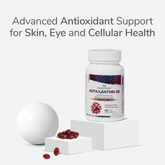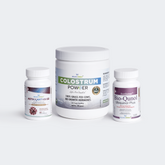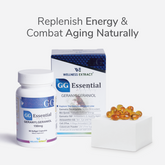Estimated Reading Time: 7 minutes
|The joy of becoming a mother is unparalleled! One of the most beautiful and cherished experiences a woman can have.
From the moment your baby arrives, your body begins an incredible journey of care, nourishment, and protection, long before you even realize it.
And, postpartum, the care continues beautifully through your breast milk. Filled with immense nutrients and immune boosters, breast milk is the first and most powerful gift to your newborn.
But here's something more fascinating: breast milk isn't just one thing.
Your baby doesn't receive the same milk from day one to several months later. Instead, your milk evolves through three different stages, adapting perfectly to your baby's growing needs.
In this article, we'll take you through the A-to-Z of the three types of breast milk: colostrum, transitional milk, and mature milk.
The Beautiful Science Behind Breastfeeding
Just like pregnancy, breastfeeding is a natural process, also known as nursing or chest feeding. It is a beautiful and nurturing process through which humans feed their babies directly from their breasts.
Human breast milk has a unique nutritional and immunological composition that cannot be replicated by formula, providing essential micronutrients, growth factors, and bioactive components. Human milk also contains beneficial microbiota and microRNAs that play a crucial role in infant development and immunity.
Read More: When Does Breast Milk Come In?
Importance of Breastmilk (In Babies & Mothers)
Research shows that breastfed babies have stronger immune systems and lower risks of certain infections, including diarrhea, diabetes, obesity, and vomiting.
Exclusively breastfeeding is recommended for the first six months of life to ensure optimal infant health and development. Moreover, if 90% of babies are exclusively breastfeeding, it might reduce the infant death rates in the US. Exclusively breastfeeding is recommended for the first six months of life to ensure optimal infant health and development.
Not only for babies, but breastfeeding is also beneficial for mothers. Here is what science says about it:
-
Every 12 months of breastfeeding reduces the developmental risk of breast cancer by 4.3% in women.
-
Breastfeeding beyond 5 months can reduce the risk of type 2 diabetes in mothers by improving insulin sensitivity.
-
Moreover, longer breastfeeding is often associated with a lower risk of hypertension in women.
The consistency, color, and nutrients of breast milk change throughout motherhood. These changes occur naturally as part of the breastfeeding process. All three types of breastmilk are vital to supporting a baby's nutritional needs throughout life.
What are the 3 Types of Breast Milk for Babies?
Let's talk about the three types of breastmilk humans produce, their composition, and their duration in detail.
-
Colostrum: Nature's First Superfood
Colostrum, also called 'liquid gold ', is the first stage of breast milk production and the first breast milk produced immediately following a newborn's birth.
In the early days after birth, colostrum is especially important for a newborn's development, providing essential nutrients and immune protection. It also contains immunoglobulins, antibodies that provide passive immunity and shield against severe diseases like jaundice.
In most mammals, colostrum is either yellowish or creamy in color and thicker than the milk produced in later stages.
Duration: Colostrum is produced in the days after birth and continues for the first few days.
Nutritional Profile: Colostrum is rich in protein, vitamins, lactoferrin, minerals, and immunoglobulins. Secretory IgA is a key immune component in colostrum, providing crucial protection for infants. Compared to other milk types, colostrum generally has a low-fat and lactose composition. The table compiling the nutritional profile of colostrum is given below.
|
Nutritional Profile of Colostrum |
||
|
Proteins |
Immunoglobulins and lactoferrin |
Cellular development and protection |
|
Vitamins |
Vitamin A, Vitamin C, Vitamin D, and Vitamin B12 |
Promote overall vitality |
|
Minerals |
Calcium, phosphorus, iron, zinc, magnesium, and potassium |
Bone strength and development |
|
Bioactive Compounds |
Growth factors, amino acids, Erythropoietin, and other important enzymes |
Stimulate cell growth |
|
Immunoglobulins |
IgA, IgG, and IgM |
Build passive immunity among infants |
-
Transitional Milk: Bridge Between Colostrum and Mature Milk
Transitional milk is the second phase of breast milk, a bridge between first-produced milk and mature milk. After 2-3 days of birth, transitional milk replaces the colostrum. This change is a gradual transition, as the milk slowly evolves from colostrum to mature milk over the early postpartum period.
During this stage, your breasts may feel fuller, firmer, and possibly a little uncomfortable due to increased milk production. Unlike colostrum, transitional milk contains high levels of fats and lactose, which are responsible for energy production in young ones.
Duration: Transitional milk is produced 2-3 days after birth and continues for around a week or two.
Nutritional Profile: Transitional milk is rich in fats, calories, and lactose. These meet the increased energy demands of growing kids. It also contains water-soluble vitamins and immunoglobulins, which are essential for various bodily functions.
Also Read: Colostrum vs Breast Milk: Key Differences You Should Know
-
Mature Milk: Final Stage of Breastfeeding
Mature milk is the last stage of breastfeeding and is the primary source of food and energy for the baby throughout the cycle. Unlike colostrum and transitional milk, the composition of mature milk remains consistent. It may appear white or slightly bluish, depending on the stage of the cycle. Mature milk is further classified into two broad categories:
Foremilk
-
Produced at the beginning of the feeding cycle.
-
Rich in lactose and provides instant energy for growing kids.
-
Thin consistency, due to its high-water content.
-
Lower fat content (which increases over time).
Hind Milk
-
Produced after foremilk.
-
Abundant levels of fat.
-
Richest, thickest, creamiest, and calorie-dense milk.
-
Helps babies gain their ideal weight.
The whey protein in mature milk is easily digested by infants, allowing for quick absorption and gentle processing in their digestive systems. The fat content and nutrient profile can change within a single pumping session and between different pumping sessions, making each feeding unique.
Duration: The duration of mature milk depends on the mother's choice: how long she continues breastfeeding. It can be months or even years.
Nutritional Profile: Mature milk, often called a complete food, is full of macronutrients and micronutrients. Here is a table showing the nutritional composition of mature milk.
|
Nutritional Profile of Mature Milk |
||
|
Macronutrient |
Carbohydrates, proteins, and fats |
Support immunity, energy production, and development |
|
Micronutrient |
Vitamins and minerals |
Improve overall functionality |
|
Trace Minerals |
Iron, copper, and zinc |
Crucial for physiological processes |
If you are a mother or planning to be one soon, you need to acknowledge these three types of breastmilk and make an informed decision for your baby. All three types of breastmilk are important for a baby’s development. In later stages, you may consider supplementing your toddler with bovine colostrum.
Also Read: Is It Safe to Refreeze Breast Milk? What You Need to Know
A Word from Wellness Extract
Breastfed milk is no less than a boon to your baby. However, we know that, at times, breastfeeding or even the thought of it can be overwhelming. In such cases, remember that you are not alone.
Don't hesitate to seek support from your network, doctors, friends, and especially other mothers who have been through similar experiences. Their guidance and support can make this journey much easier.
Lastly, remember that motherhood is a beautiful phase that bonds you and the baby together. Embrace every emotion with love and patience.
Disclaimer: This content is for informational purposes only and is not intended as medical advice. The FDA has not evaluated these statements. Products mentioned are not intended to diagnose, treat, cure, or prevent any disease.
Frequently Asked Questions (FAQs)
Q1. What are the three types of breast milk?
In humans, mothers produce three types of breast milk: colostrum, transitional milk, and mature milk. Colostrum is made immediately after birth, transitional milk is produced until up to two weeks postpartum, and mature milk comes in after that.
Q2. What is the difference between foremilk and hindmilk?
Both foremilk and hindmilk are subtypes of mature milk. Foremilk comes first and is thinner, serving the baby's needs for thirst. On the other hand, hindmilk is thicker, followed by foremilk, helping the baby gain weight.
Q3. Why does my breastmilk have different colors?
Breast milk may vary in color due to various factors, including the stage of lactation, diet, and medical conditions. Sometimes, blood or dietary changes may also influence the color of breast milk.
Q4. What are the signs that an infant is getting enough breast milk?
If your baby is getting enough breast milk, he will look healthy and gain weight. They also appear relaxed, have round cheeks, and will have moist mouths after feeding.
Q5. Why am I not producing enough milk?
There can be different factors for low milk production, including maternal health issues, frequent feeding, medications, and certain lifestyles like smoking and alcohol.\
References:
- Victora CG, Bahl R, Barros AJD, et al. Breastfeeding in the 21st century: epidemiology, mechanisms, and lifelong effect. Lancet. 2016;387(10017):475-490. doi:10.1016/S0140-6736(15)01024-7. Available from: https://www.ncbi.nlm.nih.gov/pmc/articles/PMC6950830/
- Ip S, Chung M, Raman G, et al. Breastfeeding and maternal and infant health outcomes in developed countries. Evid Rep Technol Assess (Full Rep). 2007;(153):1-186. Available from: https://www.ncbi.nlm.nih.gov/books/NBK38337/
- Stuebe AM. The risks of not breastfeeding for mothers and infants. Rev Obstet Gynecol. 2009;2(4):222-231. Available from: https://www.ncbi.nlm.nih.gov/pmc/articles/PMC2812877/
- Ballard O, Morrow AL. Human milk composition: nutrients and bioactive factors. Pediatr Clin North Am. 2013;60(1):49-74. doi:10.1016/j.pcl.2012.10.002. Available from: https://www.ncbi.nlm.nih.gov/pmc/articles/PMC3586783/
- Kunz C, Rodriguez-Palmero M, Koletzko B, Jensen R. Nutritional and biochemical properties of human milk, Part I: General aspects, proteins, and carbohydrates. Clin Perinatol. 1999;26(2):307-333. doi:10.1016/S0095-5108(18)30078-5. Available from: https://pubmed.ncbi.nlm.nih.gov/10394473/






































